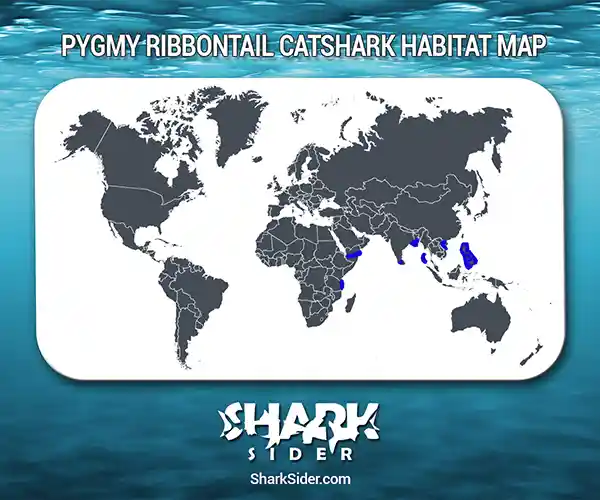The Pygmy Ribbontail catshark, one of the smallest shark species, gets its name from the dark bands on its tail fin.
It is a type of Finback catshark native to patches of the western Indo-Pacific, named after Lewis Radcliffe, the General Assistant and Naturalist on board the vessel. It was first caught during the 1907-1910 expedition of the U.S. Fish Commission Steamer Albatross to the Philippines.
Pygmy Ribbontail Catshark Scientific Classification |
|
| Kingdom | Animalia |
| Phylum | Chordata |
| Class | Chondrichthyes |
| Order | Carcharhiniformes |
| Family | Proscylliidae |
| Genus | Eridacnis |
| Scientific name | E. radcliffei |
Description
The Pygmy Ribbontail catshark is a tiny species with males growing to 18-19 cm (7 in) and females averaging 15-16 cm (6 in). The largest specimens measured 23 cm (9.1 in) for males and 24 cm (9.4 in) for females, respectively. Their weight was recorded with a 24.2 cm (9.5 in) long pregnant female that weighed 37 g (1.3 oz) and an adult male 18.6 cm (7.3 in) long weighing 14 g (0.5 oz).
It has a slim, dark brown body with black blotches on its dorsal fins and characteristic blackish bands on its long tail. The snout is short and blunt with a V-shaped mouth, long, oval eyes equipped with nictitating membranes, and nostrils with triangular skin flaps. The mouth has multiple rows of small, cusped teeth with comb-like sides. Papillae are present on the edges of the gill arches and the roof of the mouth.
The two dorsal fins are similar-sized and lack spines. The first is placed close to the pectoral fins, and the other originates near the anal fin. This anal fin is smaller than half the dorsal fins’ height. The caudal fin is long, narrow, and low, nearly a quarter of its total length.
Where do they live
Map Of The Pygmy Ribbontail Catshark’s Habitat

This species has an uneven distribution all over the western Indo-Pacific Ocean, from Tanzania to the Philippines. It has a great range (22°N-10°S) that includes the Gulf of Aden, the Bay of Bengal, The Andaman Islands, the Gulf of Mannar, and Vietnam. It is especially abundant in southern India and the Philippines. A bottom-dwelling species, it inhabits the muddy upper continental slope at depths of 71-766 m (232-2,513 ft).
Behavior
Dietary
Their primary diet consists of bony fish like lanternfish, bristlemouths, and small eels. They also feed on crustaceans and squid.
Reproductive
The females are ovoviviparous, giving birth to 1-2 huge pups compared to the mother. These newborns are usually around 11 cm (4.3 in) long. The females can get pregnant at 16.6 cm (6.5 in). However, only females over 18 cm (7 in) can sustain fully formed fetuses. Due to this, researchers believe they grow very quickly during the gestation period.
The males become sexually active at 18-19 cm (7.1-7.5 in) and females at 15-16 cm (5.9-6.3 in) long.
Adaptations
Some studies hint that they may exhibit fluorescence, yet this is unproven. Apart from this, they have many standard features such as a keen sense of sight and smell, streamlined bodies, and sharp teeth for hunting.
Human interactions
This shark has little to no economic value, only caught as bycatch by deep sea trawlers on the Philippine coast. There are no conservation efforts, and the IUCN has marked it as “Least Concern” or “LC.”
